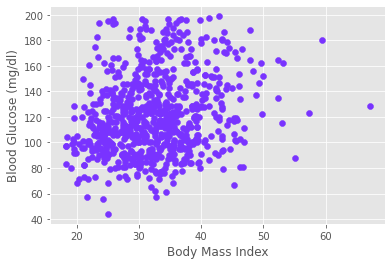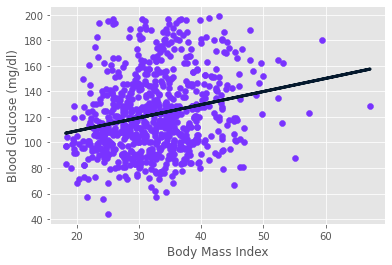Introdução à regressão
Aprendizado Supervisionado com o scikit-learn

George Boorman
Core Curriculum Manager, DataCamp
Predição dos níveis de glicose no sangue
import pandas as pd
diabetes_df = pd.read_csv("diabetes.csv")
print(diabetes_df.head())
pregnancies glucose triceps insulin bmi age diabetes
0 6 148 35 0 33.6 50 1
1 1 85 29 0 26.6 31 0
2 8 183 0 0 23.3 32 1
3 1 89 23 94 28.1 21 0
4 0 137 35 168 43.1 33 1
Criação de matrizes de variáveis independentes e dependentes
X = diabetes_df.drop("glucose", axis=1).values y = diabetes_df["glucose"].valuesprint(type(X), type(y))
<class 'numpy.ndarray'> <class 'numpy.ndarray'>
Previsões com base em uma única variável independente
X_bmi = X[:, 3]print(y.shape, X_bmi.shape)
(752,) (752,)
X_bmi = X_bmi.reshape(-1, 1)print(X_bmi.shape)
(752, 1)
Gráfico de glicose x índice de massa corporal
import matplotlib.pyplot as pltplt.scatter(X_bmi, y)plt.ylabel("Blood Glucose (mg/dl)") plt.xlabel("Body Mass Index") plt.show()
Gráfico de glicose x índice de massa corporal

Ajuste de um modelo de regressão
from sklearn.linear_model import LinearRegressionreg = LinearRegression()reg.fit(X_bmi, y)predictions = reg.predict(X_bmi)plt.scatter(X_bmi, y)plt.plot(X_bmi, predictions) plt.ylabel("Blood Glucose (mg/dl)") plt.xlabel("Body Mass Index") plt.show()
Ajuste de um modelo de regressão

Vamos praticar!
Aprendizado Supervisionado com o scikit-learn

